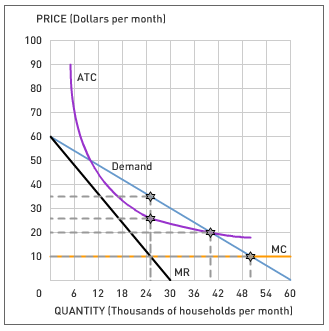Monopolist under an average-cost pricing policy
$2.00







Text:
Consider the local telephone company, a natural monopoly. The following graph shows the demand curve for phone services, the company’s marginal revenue curve (labeled MR), its marginal cost curve (labeled MC), and its average total cost curve (labeled ATC). You can hover over the points on the graph to see their exact coordinates. Assume no government regulation. If the natural monopoly provides the profit-maximizing output, it will provide Suppose that the government forces the monopolist to set the price equal to marginal cost. In the short run, under a marginal-cost pricing regulation, the monopolist will provide phone services to at a price of If the government forces the natural monopoly to set its price equal to marginal cost, how will the company react in the long run? Because the firm earns a profit under marginal-cost pricing, it will remain in the industry in the long run. Because the firm suffers an economic loss under marginal-cost pricing, it will exit the industry in the long run. O Because the firm suffers an economic loss under marginal-cost pricing, it will reduce its output to 25,000 households per month in the long run.
Suppose that the government forces the natural monopoly to set its price equal to average cost. Under an average-cost pricing policy, the monopolist would provide phone services to price of I and earn a profit of per month. True or False: Under the average-cost pricing policy, the telephone company has no incentive to cut costs.